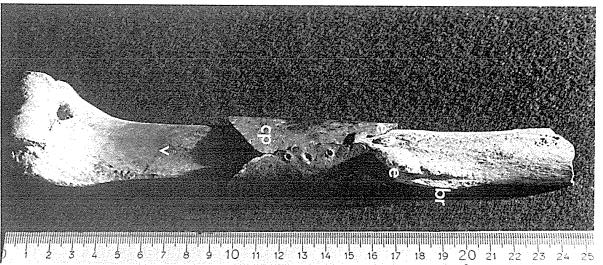 |
| Picture of Varnhem humerus (from Swedish Wikipedia page on Varnhem) |
Varnhem is now a small, and shrinking, town in the middle of nowhere in south-central Sweden. The Varnhem Cistercian monastery is historically prominent as a center of early Swedish Christianity, with Christian graves dating back to the 800s, and as the burial place of Swedish regent Birger Magnusson, who founded the new capital of Stockholm in 1252. The Varnhem humerus was found in the cloister aisle in 1928. It probably dates to between 1260 and 1527 and is remarkable because it shows signs of healing after being repaired with a copper-sheet cylinder. It is a unique example of seemingly anachronistic, successful, advanced surgery from the Middle Ages. My initial reaction when I heard about it was very skeptical, but Hallbäck's scholarly work on the topic seems convincing to me, as a layman in this area.
With the usual search engines, I could not find Hallbäck's paper, published in the journal "Ossa: international journal of skeletal research". However, using LIBRIS, the catalog search engine for all Swedish libraries, I found a PDF with a scan of the relevant issue. I extracted a 1.1 MB PDF with the paper of interest: Hallbäck, D.-A. (1976/7). A Medieval (?) bone with a copper plate support, indicating an open surgical treatment. Ossa 3/4, 63–82. It's a 20-page paper, written in English, and well worth a read in its entirety. There are 12 figures, 4 of them X-ray images, providing very compelling evidence.
In summary Hallbäck finds that the humerus is probably from the late medieval time period, 1260-1527, and less probably from 1150-1260. There is also a slight chance that the bone is as recent as from 1674-1695 (hence the awkward question mark in the title of the paper), when the church was used for burials of nobility, but its location in the monastery, not the church, contradicts that. Carbon-14 dating could not be used without unacceptable damage to the bone. The bone is wrapped in a "remarkably pure copper" cylinder, 7.3 cm long, and and about 0.7 mm thick. The cylinder has three pairs of holes, where it would have been held together by rivets, or similar, now gone. When the holes are lined up, the cylinder snugly fits around the bone. The paper refers to the cylinder material as copper plate, but if I went to Home Depot to buy some, I'd ask for copper sheet. A plate would be thicker and not possible to bend with your bare hands. The bone has a healed fracture ("proliferative bone reaction"), a porous area indicative of infection, and two "exostoses", bone growths on the surface of the bone, the larger of which has begun to cover the copper sheet! There is thus overwhelming evidence that the patient survived the surgery and recovered.
 |
| Figure 5 from the paper. The copper sheet is marked "cp", the proliferative bone reaction "br" and the exostoses "e". |
The paper concludes: "My assumption is that the injury was caused by a cut from, for instance an axe or a sword, which led to an open wound, with the bared bone visible. The bone was probably not cut in two pieces. The plate was placed round the bone to bring about stabilization. At the same time, the pure copper had an antibacterial effect on the wound. Whether this effect was deliberate or not is impossible to say. Judging from the bone, and considering the well developed exostoses and the proliferative bone reaction, as well as the lack of fracture notches on the X-ray pictures, the patient must have survived for years, may be decades. Note that nothing can be said about the function of the arm after the operation".
My speculation is that the patient was a warrior and local nobleman with rare access to state-of-the-art medical care provided by Cistercian monks at the Varnhem monastery. His left arm was nearly severed in combat when an axe splintered his shield, peeled the flesh off the bone on the outside of the upper arm and fractured the bone. By the time he reached Varnhem the wound was infected and his physician decided to kill two birds with one stone and use a copper sheet wrapped around the already partially exposed bone to both stabilize the fracture and fight the infection. The recovery of the patient is impressive, but I find the skill of the physician even more impressive. Quoting Hallbäck: "The fixation of the plate so closely to the bone as in this case entails seriously damaged soft parts, and it is a true surgical exploit to carry through this operation so that the patient survived". Where did this Cistercian monk learn to perform medicine at this level? Was this kind of medical knowledge widespread within his order? Did he attend medical school at one of the handful of universities that existed at the time in continental Europe (Sweden's first university, in Uppsala, did not open until 1477)?
